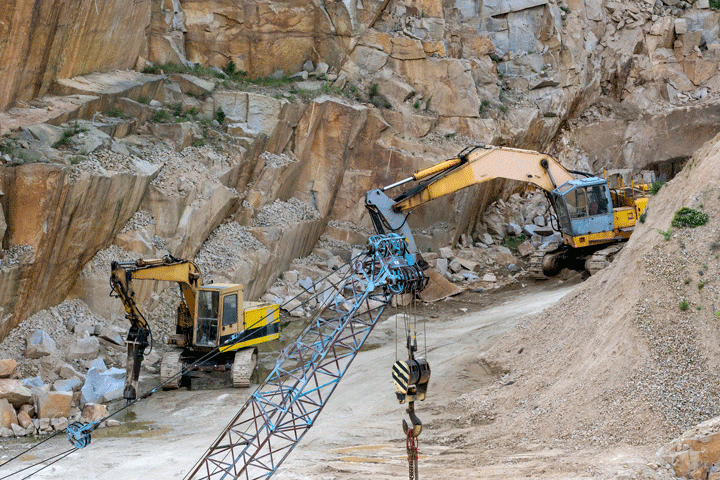Unearthing the Rich Background and Sustainable Practices of Granite Quarrying
As we depend on the precipice of uncovering the intricate tapestry of granite quarrying, a journey through time reveals not simply the physical act of extracting stone however likewise the cultural and historical relevance woven into the very fabric of this technique. From the ancient beginnings that laid the structure for modern quarrying techniques to the sustainable techniques that are forming the future of this sector, each sculpt mark on granite surfaces tells a story waiting to be uncovered (granite quarries in south africa). The heritage of granite quarrying stretches much beyond simple extraction; it is a testimony to human resourcefulness, resilience, and the enduring appeal of this stunning rock
Old Beginnings of Granite Quarrying
Going back to old worlds, the method of quarrying granite has been an essential part of human history and architectural improvement. The earliest proof of granite quarrying go back to ancient Egypt, where substantial pyramids and elaborate sculptures were crafted from this resilient stone. The Egyptians made use of primitive devices to remove granite blocks from quarries, showcasing the importance of this material in their monumental buildings.
Relocating forward in history, the Greeks also made considerable contributions to the quarrying of granite. The Greeks utilized granite in different building wonders, such as holy places and statues, demonstrating their ability in shaping and carving this durable rock. The Romans better fine-tuned the strategies of quarrying granite, utilizing sophisticated tools like blades and hammers to essence and shape granite for their renowned structures.
Through the centuries, the practice of quarrying granite has developed, with contemporary innovations improving performance while keeping the ageless charm of this all-natural rock - granite quarries in south africa. From ancient people to contemporary builders, the legacy of granite quarrying remains to form our globe
Development of Quarrying Techniques
The development of quarrying strategies has been marked by a continuous development in the direction of better effectiveness and accuracy in extracting granite. Early quarrying methods included hand-operated labor with standard tools such as knives, hammers, and wedges to remove granite blocks from the earth.
In even more current times, the advent of machinery reinvented the quarrying industry, enabling faster extraction prices and raised performance. Technologies such as diamond cable saws, high-pressure water jets, and pneumatic drills have ended up being typical in modern-day quarries, enabling for accurate cutting and lowered waste. Improvements in computer-controlled devices and 3D modeling have actually enhanced quarrying procedures, leading to minimal ecological impact and improved sustainability methods. As the demand for granite proceeds to increase, the evolution of quarrying techniques stays essential to meeting market needs efficiently and sustainably.
Cultural Significance of Granite
Granite holds an extensive social relevance throughout numerous human beings as a result of its enduring existence in building masterpieces and admired monoliths. From the stunning pyramids of Egypt to the detailed makings of the Angkor Wat temple in Cambodia, granite has been a material of option for expressing splendour and long life in cultural heritage. In ancient Rome, granite columns adorned holy places and public buildings, symbolizing toughness and permanence. The cultural value of granite prolongs past its physical qualities; it embodies strength, stability, and eternity, making it a symbol of sustaining heritages and customs.

Sustainable Practices in Quarrying
Amidst the abundant history of granite quarrying and its social relevance lies a growing focus on lasting methods within the market. As environmental recognition and issues about resource depletion have actually heightened around the world, the quarrying industry has significantly welcomed sustainable approaches to decrease its effect on the environment and surrounding areas.

Moreover, reclamation and rehabilitation of quarry sites post-extraction are integral to lasting methods. By bring back quarried locations to a natural or helpful state, such as developing wild animals habitats or leisure rooms, quarriers can balance out the ecological impact of their procedures and add positively to the neighborhood ecological community.
Tradition of Granite Quarrying
With a historic backdrop steeped in craftsmanship and industrial progression, what sustaining impact has granite quarrying left on the landscape of modern culture? The tradition of granite quarrying goes beyond mere extraction practices; it has actually shaped architectural wonders, metropolitan landscapes, and cultural heritage worldwide. The durable nature of granite has made it a preferred choice for monoliths, structures, and framework, standing as a testament to the skill and virtuosity of quarry workers see this website throughout generations.
Furthermore, the financial impact of granite quarrying can not be forgotten. The market remains to offer employment possibility and drive neighborhood economic situations in areas where granite removal prevails. It has actually likewise stimulated technical innovations in quarrying techniques and equipment, causing much more reliable and sustainable techniques.
In regards to sustainability, the legacy of granite quarrying includes initiatives to reduce environmental effects through improvement projects and accountable resource administration. By balancing financial rate of interests with ecological stewardship, the industry strives to make sure that future generations can proceed to gain from this enduring natural deposit.
Conclusion
